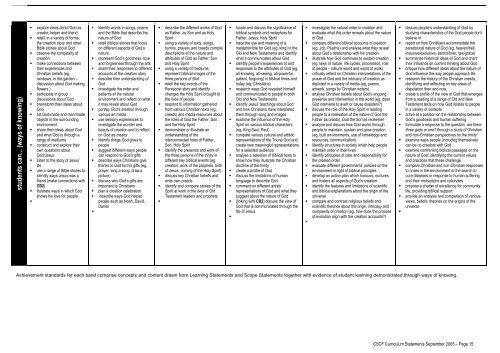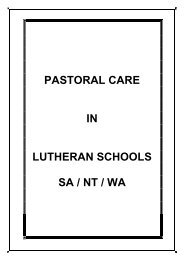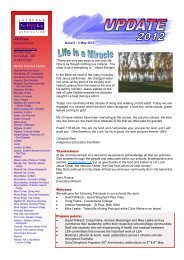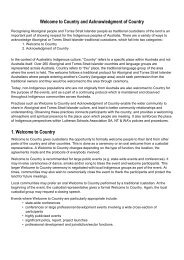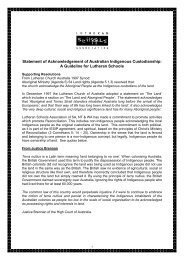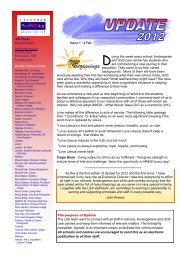2012 CSCF Curriculum Statements.pdf - Lutheran Schools ...
2012 CSCF Curriculum Statements.pdf - Lutheran Schools ...
2012 CSCF Curriculum Statements.pdf - Lutheran Schools ...
You also want an ePaper? Increase the reach of your titles
YUMPU automatically turns print PDFs into web optimized ePapers that Google loves.
students can... (ways of knowing)• explore ideas about God ascreator, helper and friend• retell, in a variety of forms,the creation story and otherBible stories about God• observe the complexity ofcreation• make connections betweentheir experiences andChristian beliefs (eg,rainbows, in the garden –discussion about God makingflowers )• participate in groupdiscussions about God• brainstorm their ideas aboutGod• list God-made and man-madeobjects in the surroundingenvironment• share their ideas about Godand what God is through arange of mediums• construct and explore theirown questions aboutGod/Jesus• listen to the story of Jesus’life• use a range of Bible stories toidentify ways Jesus was afriend (make connections withCB2)• illustrate ways in which Godshows his love for people•• identify words in songs, poemsand the Bible that describe thenature of God• retell biblical stories that focuson different aspects of God’snature• represent God’s goodness, loveand forgiveness through the arts• share their responses to differentaccounts of the creation story• describe their understanding ofGod• investigate the order andpatterns of the naturalenvironment and reflect on whatit may reveal about God• portray God’s creation throughvarious art media• use sensory experiences toinvestigate the wonder andbeauty of creation and to reflecton God as creator• identify things God gives topeople• suggest different ways peoplecan respond to God’s gifts• describe ways Christians givethanks to God for his gifts (eg,prayer, sing a song, draw apicture)• discuss why God’s gifts areimportant to Christians• plan a creation celebration• describe ways God helpedpeople such as Noah, David,Daniel•• describe the different works of Godas Father, as Son and as HolySpirit• using a variety of texts, songs,hymns, prayers and creeds compiledescriptions of the nature andattributes of God as Father, Sonand Holy Spirit• using a variety of mediums,represent biblical images of thethree persons of God• retell the key events of thePentecost story and identifychanges the Holy Spirit brought tothe lives of people• respond to information gatheredfrom various Christian texts (eg,creeds) and media resources aboutthe roles of God the Father, Sonand the Holy Spirit• demonstrate or illustrate anunderstanding of theinterconnected roles of Father,Son, Holy Spirit• identify the presence and work ofthe three persons of the trinity indifferent key biblical events (eg,creation, work of the prophets, birthof Jesus, coming of the Holy Spirit)• discuss key Christian beliefs andwrite own creeds• identify and compare stories of theSpirit at work in the lives of OldTestament leaders and prophets•• locate and discuss the significance ofbiblical symbols and metaphors forFather, Jesus, Holy Spirit• trace the use and meaning of ametaphor/title for God (eg, king) in theOld and New Testaments and identifywhat it communicates about God• identify people’s experiences of andresponses to the attributes of God (eg,all-knowing, all-seeing, all-powerful,patient, forgiving) in biblical times andtoday (eg, Christians)• research ways God revealed himselfand communicated to people in bothOld and New Testaments• identify Jesus’ teachings about Godand how Christians have interpretedthem through song and images• examine the influence of the HolySpirit on various biblical characters(eg, King Saul, Paul)• compare various cultural and artisticrepresentations of the Triune God andcreate new meaningful representationsfor a selected audience• analyse a selection of biblical texts toshow how they illustrate the Christiandoctrine of the trinity• create a profile of God• discuss the limitations of humanlanguage to describe God• comment on different artists’representations of God and what theysuggest about the nature of God• (linking with CB2) discuss the view ofGod that is communicated through thelife of Jesus•• investigate the natural order in creation andevaluate what this order reveals about the natureof God• compare different biblical accounts of creation(eg, Job, Psalms) and analyse what they revealabout God’s relationship with his creation• illustrate how God continues to sustain creation(eg, laws of nature, life cycles, procreation, roleof people – natural world and world of work)• critically reflect on Christian interpretations of thepower of God and the intricacy of creation asdepicted in a variety of media (eg, poems,artwork, songs by Christian writers)• analyse Christian beliefs about God’s ongoingpresence and intervention in the world (eg, doesGod intervene to avert or cause disasters?)• discuss the role of the Holy Spirit in leadingpeople to a realisation of the nature of God theFather as creator, God the Son as redeemer• analyse and discuss how God works throughpeople to maintain, sustain and grow creation(eg, built environments, use of knowledge andresources, communication)• identify structures in society which help peoplemaintain order in their lives• identify principles of care and responsibility forthe created order• evaluate different governments’ policies on theenvironment in light of biblical principles• develop an action plan which honours, nurturesand fosters all aspects of God’s creation• identify the features and limitations of scientificand biblical explanations about the origin of theuniverse• compare and contrast religious beliefs andscientific theories about the origin, intricacy andcomplexity of creation (eg, how does the processof evolution align with the creation accounts?)•• deduce people’s understanding of God bystudying characteristics of the God people don’tbelieve in• report on how Christians accommodate theparadoxical nature of God (eg, heaven/hell,inclusive/exclusive, saint/sinner, law/grace)• summarise historical ideas of God and charttheir influence on current thinking about God• critique how different ideas about the nature ofGod influence the way people approach life• research the history of the Christian creeds,identifying and reflecting on key areas ofdisputation then and now• create a profile of the view of God that emergesfrom a reading of a range of Old and NewTestament texts on how God relates to peoplein a variety of contexts• arrive at a position on the relationship betweenGod’s goodness and human suffering• formulate a response to the question, are therethree gods or one? through a study of Christianand non-Christian perspectives on the trinity• examine ways people (including themselves)can be co-creators with God• examine confronting biblical passages on thenature of God, identifying the current valuesand practices that these challenge• compare Christian and non-Christian responsesto crises in the environment or the search tocure diseases or response to human sufferingand their motivations and rationales• propose a charter of excellence for communitylife, providing biblical support• provide an analysis and comparison of variousviews, beliefs, theories on the origins of theuniverse•Achievement standards for each band comprise concepts and content drawn from Learning <strong>Statements</strong> and Scope <strong>Statements</strong> together with evidence of student learning demonstrated through ways of knowing.<strong>CSCF</strong> <strong>Curriculum</strong> <strong>Statements</strong> September 2005 – Page 15


